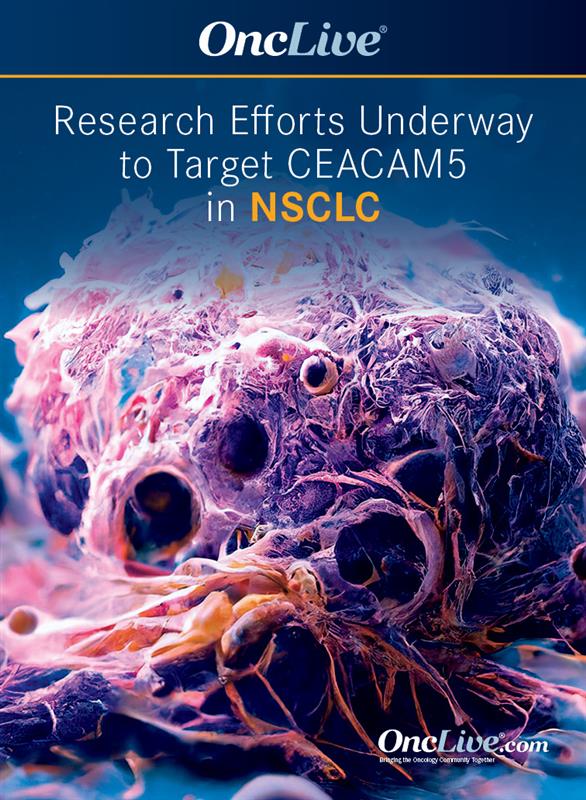Tusamitamab Ravtansine Is Under Investigation in CEACAM5+ Nonsquamous NSCLC
Tusamitamab ravtansine, an antibody-drug conjugate that targets CEACAM5, could expand the treatment armamentarium for patients with CEACAM5-positive nonsquamous non–small cell lung cancer.
Chao H. Huang, MD, FACP

Tusamitamab ravtansine (SAR408701), an antibody-drug conjugate (ADC) that targets CEACAM5, could expand the treatment armamentarium for patients with CEACAM5-positive nonsquamous non–small cell lung cancer (NSCLC), according to Chao H. Huang, MD, FACP.
The phase 2 CARMEN-LC05 trial (NCT04524689), which is currently enrolling patients with CEACAM5-positive, advanced or metastatic nonsquamous NSCLC, will investigate tusamitamab ravtansine in 5 arms. One arm will receive the ADC plus pembrolizumab (Keytruda), and the other arms will receive tusamitamab ravtansine plus pembrolizumab and either cisplatin or carboplatin with or without pemetrexed (Alimta). This study’s primary end points are safety and the determination of the recommended doses of tusamitamab ravtansine in this population.1
“[Tusamitamab ravtansine may not become a] substitute [for chemotherapy], but it could be another option in lung cancer treatment,” Huang said in an interview with OncLive®.
In the interview, Huang explained the unique properties of tusamitamab ravtansine, obstacles that arise when testing for CEACAM5 expression, and where the agent may fit among the current chemoimmunotherapy options in the treatment paradigm.
Huang is an associate professor and clinical professor of medical oncology at The University of Kansas Medical Center in Kansas City.
OncLive®: How does the mechanism of action of tusamitamab ravtansine contrast with current targeted treatment options using TKIs?
Huang: [Tusamitamab ravtansine] is an ADC that recognizes CEACAM5. This monoclonal antibody links with several molecules of chemotherapy. The idea is that when you deliver this ADC, it will seek out the tumor bed, bind to the protein, and deliver the chemotherapy to the tumor as opposed to having more of a systemic effect.
[This agent is] similar to ado-trastuzumab emtansine [Kadcyla] for breast cancer, which targets HER2 with chemotherapy, as well as [fam-trastuzumab deruxtecan-nxki (Enhertu) in] the DESTINY-Lung trials, which is also an ADC targeting HER2. [These agents are] different from TKIs because [they are not comprised of] small molecules. [Instead, they contain] monoclonal antibodies. TKIs are chemicals that enter the cancer cells, bind to the tyrosine kinase domain of the receptor, and shut it off. Monoclonal antibodies bind to the extracellular domain of the cell, where the protein is expressed. [Tusamitamab ravtansine is different from TKIs because it] doesn’t target a specific mutation, it targets the protein. It’s also delivered intravenously, as opposed to TKIs, [which are administered] orally.
Based on prior literature, is CEACAM5 found more commonly in certain subsets of NSCLC, and could that information guide treatment strategies?
It’s more expressed in adenocarcinoma and would potentially be a greater target in non–small cell adenocarcinoma histology. It probably does not have as high an expression in squamous cell [disease], therefore, it might be a more viable target in adenocarcinoma as opposed to squamous cell. [This indicates that] we need more options for squamous cell [disease].
Is this marker best identified in tissue or blood and why? What challenges can arise with identifying it?
CEACAM5 [is most often detected] in tissue. Currently, the clinical trial protocol is to send the tumor biopsy to a central lab to identify expression of this gene through immunohistochemistry [IHC]. [There are different classifications for CEACAM5 expression level based on] the percentage of cancer cells that express it. [Tumors can have] low, intermediate, or high expression. [The CARMEN-LC05 trial defines CEACAM5 expression as an IHC assay where at least 1% of the cells express the gene.]
Because [CEACAM5 detection] requires tissue, testing for it can sometimes be a challenge. Nowadays, when we do a lung cancer biopsy, we want to do molecular testing, and doing that sometimes exhausts the biopsy sample. It could be a challenge to use additional tissue for this IHC [analysis].
[Additionally], although this antibody [test] can be acquired commercially, this testing is not yet standardized, so we cannot just order it in our lab and get it done. Currently, the company uses 1 specific platform, and [testing is performed] by a central lab. In the future, once this platform is validated, [testing] can potentially be done in any lab, but our challenge right now is getting the tissue and sending it to the central lab, which can have a turnaround time of 7 to 10 days.
Testing in the blood is a bit different [because it] relies on the presence of circulating tumor cells. First, you need to identify the cancer cells in the blood, then isolate them and do IHC staining on them. Technically, it can be done, but the challenge is finding those circulating tumor cells. If you don’t find them, you cannot do the testing. Even if you do the testing, [you may not truly find] cancer cells, meaning you could have a false positive result.
The more reliable and accurate test is done in tissue. However, in the future, we may develop or refine blood-based testing to better identify CEACAM5 expression.
What is the rationale for the CARMEN-LC05 trial, and why is this research important in the context of the current treatment landscape?
This is a frontline trial using tusamitamab ravtansine in combination with pembrolizumab or pembrolizumab and platinum-based chemotherapy, with or without pemetrexed. [We are adding] the study drug, this ADC, to a checkpoint inhibitor with or without platinum and pemetrexed. [This study is] essentially [evaluating the efficacy of] giving 4 drugs vs eliminating pemetrexed. [Tusamitamab ravtansine could] be a substitute for pemetrexed, or even a substitute for both carboplatin and pemetrexed.
[This trial is] in patients [with tumors that] express CEACAM5. [CARMEN-LC05] is currently ongoing, and we have accrued some patients. The challenge has been finding patients with CEACAM5 expression. We have screened close to 20 patients, and we found about 3 patients with [CEACAM5 expression]. Many of the patients we screened did not have sufficient tissue, so we couldn’t have the testing done. Because we need the tissue for both the molecular testing and the standard of care, by the time we test for this protein, we may not have enough tissue.
Tusamitamab ravtansine is also being studied in the phase 3 CARMEN-LC03 (NCT04154956) and phase 2 CARMEN-LC06 (NCT05245071) trials. Based on all this research, where do you believe this agent will demonstrate the most activity and why?
Those trials are in the second line. This drug will probably be effective regardless of the line of therapy, in both the first and second lines. Other ADCs, like those in breast cancer, were first found to be active in metastatic disease and are now moving to the frontline and even adjuvant settings.
In lung cancer, we’ll probably see [a similar pattern] with [tusamitamab ravtansine]. [It might be] effective in the second-line setting, and it’s been tested in the frontline setting. Once all these studies mature, this agent will be a potential option in either the first- or second-line settings. If the cancer expresses this gene, meaning the target is present, the drug should be active.
One issue still to be worked out is the adverse effect [AE] profile of this agent. One AE is uveitis, an eye irritation. Withholding the drug and managing patients’ symptoms seems to resolve it, and it doesn’t seem to recur when rechallenging these patients with the same drug. We need more education and comfort from physicians [regarding these AEs when we] start using this drug in the future.
Pending positive data from the CARMEN trials, do you see this ADC-based regimen being favored over current chemoimmunotherapy combinations?
It might not be favored, but it could certainly be an add-on and a potential option. In patients who need chemotherapy added to checkpoint inhibitors, if [CARMEN-LC05] proves that tusamitamab ravtansine can take the place of carboplatin and pemetrexed, it might be better to use the ADC instead of giving 2 chemotherapies. Maybe that will reduce the toxicity.
The demise of chemotherapy is being greatly exaggerated. We are still using it. Despite the existence of TKIs and some of the other antibody therapies, we still need to use chemotherapy once patients progress on TKIs or monoclonal antibodies. Chemotherapy will not go away. It may be used in conjunction with some of these new drugs or in sequence.
What other investigational approaches in this population would you like to highlight?
I have been working with the company to propose a potential trial using tusamitamab ravtansine as consolidation after chemoradiation. Although this is an idea in development, [this agent] may be used in stage III disease in the future. Future programs or projects [may investigate this agent] in the adjuvant or neoadjuvant settings once it has been proven active and the AE profile is found to be manageable and without major issues.
Reference
Tusamitamab ravtansine (SAR408701) in combination with pembrolizumab and tusamitamab ravtansine (SAR408701) in combination with pembrolizumab and platinum-based chemotherapy with or without pemetrexed in patients with NSQ NSCLC (CARMEN-LC05) (CARMEN-LC05). ClinicalTrials.gov. Updated December 13, 2022. Accessed January 11, 2023. https://clinicaltrials.gov/ct2/show/NCT04524689




